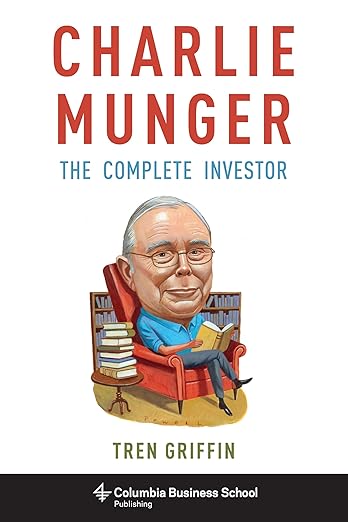Your cart is currently empty!
02.0007 Charlie Munger The Complete Investor

Charlie Munger The Complete Investor
2015 Trend Griffin
Columbia Business School Publishing
| Chapter | Value Investing |
|---|---|
| Introduction | Munger: I’m a great believer in solving hard problem by using a checklist. You need to get all the likely and unlikely answers before you; otherwise it’s easy to miss something important. Buffett: If you cannot write it down, you have not thought it through. |
| The 4 fundamental principles of value investing as created by Ben Graham are as follows: 1. Treat a share of stock as a proportional ownership of the business. 2. Buy at a significant discount to intrinsic value to create a margin of safety. 3. Make a bipolar Mr. Market your servant rather than you master. 4. Be rational, objectives, and dispassionate. | |
| 1. The Basics of Graham Value Investing System | If you cannot accept investing underperformance in the short term in order to achieve long-term investment outperformance, then you are not a candidate for Graham value investing. |
| Graham value investing would not work if markets were perfectly efficient. For this reason, the market’s folly is the fundamental source of the Graham value investor’s opportunity. | |
| 2. The Principles of the Graham Value Investing System | 1. Treat a Share of Stock as a Proportional Ownership of a Business. 2. Buy at a Significant Discount to Intrinsic Value to Create a Margin of Safety. 3. Make “Mr. Market” Your Servant Rather Than Your Master. 4. Be Rational, Objectives, and Dispassionate. |
| 3. Worldly Wisdom | Munger believes that by using a range of different models from many different disciplines – psychology, history, mathematics, physics, philosophy, biology, and so on – a person can use the combined output of the synthesis to produce something that has more value than the sum of its parts. |
| Buffett added that Munger has ” the best 30 second mind in the world. He goes from A to Z in one move. He sees the essence of everything before you even finish the sentence.” | |
| The most extreme mistakes in Berkshire’ history have been mistake of omission (Wal-Matt, Television Station): 1. Doing nothing – what Buffett calls “sucking my thumb” 2. Buying with eyedropper things we should be buying a lot of. | |
| To be wise, one must also have experience, common sense, and good judgement. How one actually applies these things in life is what make a person wise. | |
| 4. The Psychology of Human Misjudgment | – |
| 5. The Right Stuff | 1. Patient 2. Disciplined 3. Calm but Courageous and Decisive 4. Reasonably Intelligent but Not Misled by Their High IQs 5. Honest 6. Confident and Nonideological 7. Long-Term Oriented 8. Passionate 9. Studious 10. Collegial 11. Sound Temperament 12. Frugal 13 Risk Averse |
| 6. The 7 Variables in the Graham Value Investing System | 1. Determining the Appropriate Intrinsic Value of a Business 2. Determining the Appropriate Margin of Safety 3. Determining the Scope of an Investor’s Circle of Competence 4. Determining How Much of Each Security to Buy 5. Determining When to Sell a Security 6. Determining How Much to Bet When You Find a Misprices Asset 7. Determining Whether the Quality of a Business Should Be Considered |
| 7. The Right Stuff in Business | 1. Capital Allocation Skills 2. Compensation Systems That Create Alignment with Shareholders 3. Moat – Widening Skills 4. Management Already in Place with Integrity 5. The Rare Exceptional Manager |
| Berkshire Math | 1. Calculation: In making intrinsic value calculation – discount to Present Value, conservative growth rate 2. Decision making: based on opportunity costs 3. Risk assessment: current earnings are nearly certain to continue 4. Investing process: focus on ROE, not EPS / PE ratio / EBITDA 5. Genuine Free Cash Flow (FCF) |
| Moats | 1. Supply-Side Economics of Scale and Scope 2. Demand-Side Economics of Scale (Network Effects) 3. Brand 4. Regulation 5. Patent and Intellectual Property |
| Berkshire moat: 1. Berkshire Is Tax Efficient 2. Berkshire Has Low Overhead 3. Berkshire is the Private Buyer of First Resort 4. Berkshire Has Permanent Capital 5. Berkshire Outperforms in Down Markets 6. Berkshire Benefits from Float 7. High-Quality Shareholders, Including Buffett and Munger | |
| Value Investing vs, Factor Investing | Ben Graham, Warren Buffett, Howard Marks and Seth Klarman – Value Investing: value investors are solving for where can one find low risk of permanent impairment of capital and a high probability of an attractive return. |
| Eugene Fama and Ken French – Factor Investing (Value Stocks): Is solving for what creates a persistent disparity of return across large numbers of stocks. |

Leave a Reply